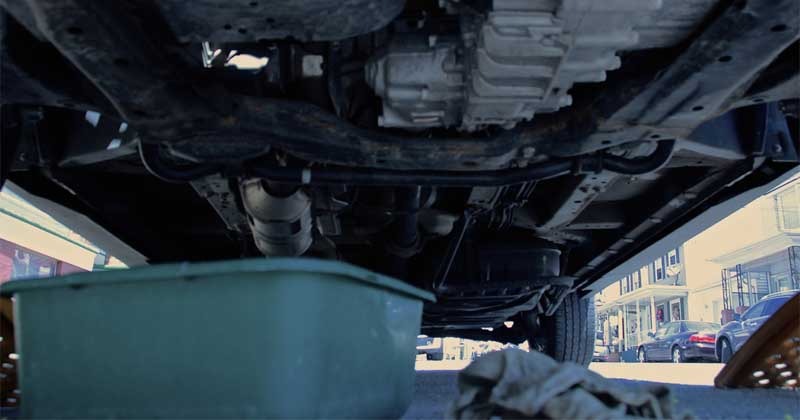[ad_1]
Disclaimer
The methods described in this post are illegal and should only be used as a last resort in an emergency.
While I don’t recommend it, knowing how to siphon gas is an important skill to learn for emergencies. You could use the siphoned gas to fuel a generator or to refuel your vehicle during evacuation.
However, it isn’t easy to siphon gas from modern cars because they have anti-siphon valves and devices.
It’s not impossible, though. You need special tools, know-how, and a lot of ingenuity.
How to Siphon Gas
1. Open the fuel door
This is the easiest part. Even if you don’t know how to pick a lock, opening the fuel door with brute force is straightforward. You can use a crowbar or the claw on the back of a hammer.
2. Use screwdriver to push aside flap over filler pipe
Almost all fuel pipes have a little metal flap over them. The flap allows you to insert a hose but will jam when you remove the siphon hose. To bypass this, all you need is a long, skinny object like a screwdriver. Use the screwdriver to push the flap aside and hold it open.
3. Siphon the gas
Stick the siphon hose into the tank and the other end into a fuel canister. Remember that siphons are one-way devices, so make sure you put the right side of the hose into the tank. Squeeze the valve, which will suction the gas out of the tank and into your canister.
*Don’t use the old method of siphoning gas with your mouth! The risk of getting a mouthful of gasoline is too great. A squeeze-bulb-type siphon will make the job a lot easier.
But wait – the car has an anti-siphon valve!
Unless you are trying to siphon gas from an old car, chances are that it has an anti-siphon device. You must bypass this to get fuel out of the tank.
What Is an Anti-Siphon Valve in a Car?
Two devices can prevent you from siphoning gas from a car.
- Anti-siphon screen: A mesh screen that prevents you from putting anything solid into the gas tank. This is typically located higher up in the fuel filler pipe.
- Rollover valve: This valve is meant to keep gas from escaping the car in the event of a rollover, but it also prevents you from sticking a siphon hose in the tank – hence why it is often called the anti-siphon valve.
How to Bypass Anti-Siphon Valve
Method 1: Park on a Slope
If the car has an anti-siphon screen but not a rollover valve, you can probably siphon most of the gas with this simple trick. It works because the anti-siphon screen is usually located quite far down the neck of the fuel filler pipe.
Just park the car on a steep slope so the filler is downhill. Your siphon hose will be able to reach some of the gasoline to siphon it out.
Method 2: Break the anti-siphon screen
It is possible to break through the anti-siphon screen in a car. I don’t recommend this because you could block the fuel outlet if any part of the screen falls into the tank.
You’ll need something long and sharp to puncture the anti-siphon screen. The problem is that metal-on-metal can create a spark. And a spark could result in a massive fire!
A good solution is to use copper. Because copper has high conductivity, it generally will not create sparks. Copper wire probably won’t be strong enough to puncture through the screen. One solution is to make a copper ring and solder it to a copper pipe. You then feed the pipe into the fuel filler tank and use the ring at the end to break the screen.
If the car only has an anti-siphon screen, you can siphon gas after breaking the screen. But, if it also has a rollover valve, you’ll need to bypass this (see method 3).
Method 3: Bypass the rollover valve
Car rollover valves allow gas to enter the tank in one direction only. Most rollover valves are either ball or butterfly-type valves.
In theory, you can bypass the rollover valve with the right tools. In practice though, this is very difficult and time-consuming to do. If the car has a rollover valve, I’d suggest skipping this method and going straight to method #4 or #5.
To bypass the rollover valve:
- You will need about 8 feet of ¼ inch plastic hose. It should be stiff but still flexible.
- Cut the end of the hose at an angle to create a narrow end.
- Stick the hose into the fuel tank.
- When you hit the rollover valve, use a twisting and pushing motion. This should get the hose past the valve and into the fuel tank.
- Attach a thicker hose to the end of the ¼ inch hose.
- Connect the thicker hose to your bulb siphon pump.
- It will take about 5 minutes of active squeezing to siphon a gallon of fuel because the hose is so narrow.
Again, this method is much more complicated than it sounds, especially since there’s no way to see if the hose is getting past the valve.
If you want to try it, I recommend buying a spare rollover valve and testing it out. You’ll be able to see what you are doing and figure out the right movements to get the hose into the valve.
Method 4: Disconnect fuel line and drain fuel
Instead of bypassing the anti-siphon screen and valve, you can access the fuel from the other side of the tank. To do this:
- Locate the fuel line.
- Disconnect the fuel line. You may need a special tool for this (like this). It’s possible to make your own fuel disconnect tool. See this video.
- Attach a hose to the end of the fuel line. Direct the other end of the hose into your canister.
- Turn the car on. The fuel pump will cause the gas to flow out of the tank and into the canister. You’ll need to keep turning the car on/off to keep the gas flowing.
- If you cannot turn on the car, you can jump the fuel pump relay terminals instead. This can be done with the engine off if you have a jumper. I haven’t tried this, but according to one source, on Toyotas, you can put a paperclip on the test plug in the engine to jump the fuel pump.
Method 5: Use fuel pressure tester with bypass valve
You can use the fuel tank Schrader valve to bypass the anti-siphon valve. The fuel Schrader valve is used for testing pressure. Not many cars have fuel line Schrader valves, so this might not be an option.
If there is a Schrader valve, you will need to get a fuel pressure test kit with a bypass valve (like this one). Hook this up, put the bypass valve hose in a canister, start the car, and then turn the bypass on. The fuel will flow into the canister.
You have to be able to turn the car on for this method to work. So, unless you also know how to jumpstart a modern car, this is only an option for siphoning fuel from your own vehicle.
Method 6: Drill a hole in gas tank
As a last resort, you can get gas from a car by drilling a hole into the tank. Put a canister underneath the hole, and gas will flow into it.
Aside from the fact that this will destroy the fuel tank, there is a considerable fire risk when drilling into metal fuel tanks. The metal-on-metal will create sparks, which can ignite the gas in the tank. Only do this on cars with plastic (polymeric) gas tanks.
Warning!
With some of these methods for siphoning gas, the car engine must be turned on. It is always a risk to handle fuel while the engine is running. To stay safe, you should:
- Use a longer hose. The hose in most siphon kits is only 2-3 feet long. Use a longer hose to position the fuel canister further away from the vehicle.
- Only siphon a few gallons at a time. Drain a few gallons from the tank. Then, turn off the car and move the canister out of the way. This way, you won’t have too much fuel sitting near the car at once.
- Siphon from a cool engine. Wait for the engine to cool down completely before you disconnect anything.
As you can see, siphoning gas from newer cars is complex and can even be dangerous. Instead of relying on your car gas tank for emergency fuel, stockpiling fuel is smarter.
This can also be tricky, though, because gasoline goes bad. Read this to learn how to store gasoline for emergencies and how long gas lasts in a can.
Have you ever siphoned gas from a modern car? Let us know your tricks and tips in the comments section below.
[ad_2]
Source link

